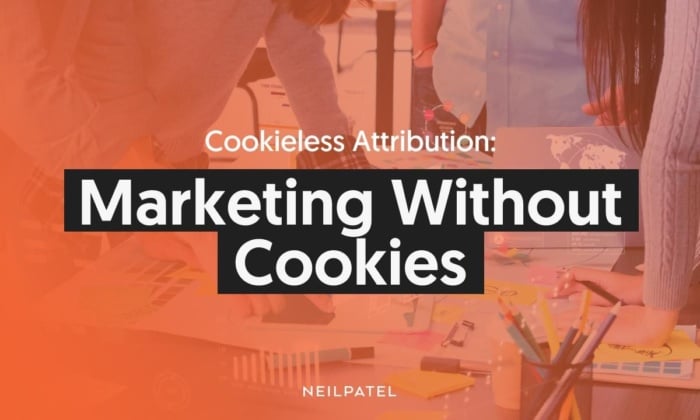
For several years, many digital marketing teams relied on cookies for marketing.
However, everything is about to change.
Mozilla Firefox and Apple Safari already block third-party cookies, and recently, Google revealed it would no longer support cookies on ad networks and its Chrome browser.
Google originally planned a phased approach starting in January 2024, meaning that all Chrome users would be cookieless by the second half of 2024. However, Google may have to put the brakes on its plans while it addresses concerns from the UK’s Competition and Marketing Authority (CMA).
The CMA is asking Google to resolve potential competition concerns related to its Privacy Sandbox, the search giant’s proposed alternative to third-party cookies. Google can’t proceed with its planned cookie deprecation scheduled for the last two quarters of the year until it addresses the CMA’s concerns.
However, that doesn’t mean you shouldn’t take action. Although Google may have to delay its timeline, you need to be ready in case it’s resolved quickly.
You still need to assess what a cookieless future means for your marketing team and how to ensure your business keeps running smoothly when you market without cookies.
This post includes…
Cookies Explained
What is Cookieless Attribution?
Why Are Third-Party Cookies Going Away & Why Does it Matter?
How Are Industry Professionals Preparing for The Loss of Third-Party Cookies?
How Does Marketing Without Cookies Work?
4 Tips to Prepare for Cookieless Marketing
Rethinking PPC: 4 Tips for PPC Marketing Without Cookies
Frequently Asked Questions About Marketing in a Cookieless Future
Conclusion
Cookies are small text files that collect information about users browsing the web. There are cookies necessary for running a site and others purely for analytical, promotional, or other non-essential purposes.
- Google is following in the footsteps of Firefox and Safari by eliminating third-party cookies in Chrome. Google has scheduled this for late 2024, but that now hinges on how quickly it addresses CMA’s competition concerns.
- Marketers need to adopt cookieless attribution techniques, such as device fingerprinting and Google Analytics 4 (GA4) server-side tracking, ahead of the transition to reduce marketing campaign disruptions.
- Cookieless attribution doesn’t mean the end of data-backed marketing. With first-party data collection and techniques like device fingerprinting, you can still use data in your marketing campaigns.
Cookies Explained
Before we dive into cookieless attribution and cookieless marketing, let’s take it back to the basics.
Cookies are small text files that collect information about users as they browse the web.
You may have noticed websites asking for your permission around cookies, like this pop-up banner below:

There are some cookies that are necessary for a site to run properly, and these are collected without consent. However, on many sites, you have the option to personalize what types of data are collected:
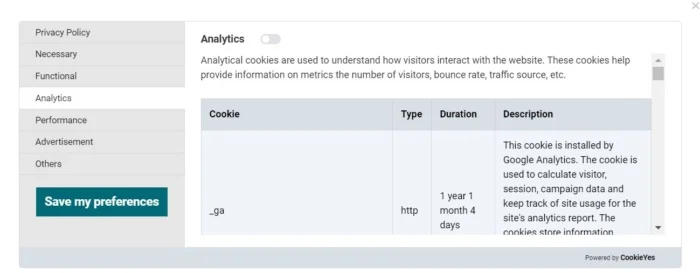
These optional cookies include things like analytics, performance, and advertisement data.
When combined, marketers can use these cookies for many purposes. For example, they can determine how customers got to a website (attribution) or how customers utilized different parts of a website. Cookies can even be used to pinpoint website performance issues!
Many marketers will also turn the above information into user personas, which are groupings of users based on similar behaviors.
What is Cookieless Attribution?
Before we can get into the nitty gritty (i.e., cookieless marketing), we need to take a step back and define cookieless attribution. Why? Cookieless marketing occurs as a result of cookieless attribution, so understanding how it works is important for your future success.
Attribution in the digital marketing space is the determination of which touchpoints contributed to a customer making a purchase. Essentially, it’s used to determine the “path” to conversion.
Attribution is often broken down into channels. These can include social media, natural search, paid search, marketing emails, etc.
So now the answer to the question: What is cookieless attribution?
Cookieless attribution is a method of collecting data—such as web traffic sources, conversions, and other marketing metrics—anonymously using techniques like server-side tracking and device fingerprinting.
Cookieless attribution accomplishes two things:
- It protects user anonymity.
- It enables marketers to continue to create marketing personas based on data, though in different ways than before.
Why Are Third-Party Cookies Going Away, and Why Does It Matter?
Whenever you use the internet, especially on browsers like Chrome, a small file called a “cookie” tracks your actions.
These cookies can help marketing teams understand user behaviors and ad performance, but they may feel like an intrusion of privacy for many users.
By blocking these cookies, users can increase their privacy and security. Browsers like Firefox, Safari, and Brave have already started doing this. Google will also begin phasing out third-party cookies from its browsers to strengthen user privacy and promote itself as a secure search engine.
This represents a considerable change for marketers relying heavily on cookies for their ad campaigns.
When creating paid ad campaigns on browsers and social media platforms, you need customer details to customize the copy. Marketing without cookies means you’d have to rely on first-party data (more on that below) rather than third-party cookies.
Now, Google is launching the Privacy Sandbox as a response to the cookieless future. Here, it will store data anonymously to form a middle ground where companies can obtain customer data without intrusive cookie tracking.
Beyond this, there are various ways to market without cookies. Below, I’ll discuss some of the most effective strategies and offer marketing tips without relying on third-party cookies.
How Are Marketing Professionals Preparing for the Loss of Third-Party Cookies?
If you think you’re alone in your fears regarding losing third-party cookies, think again.
My team at NP Digital reached out to digital marketers around the United States. Here’s what we found.
More Than Half of Respondents Expect Data Tracking and Privacy Regulation Changes to Impact Their Analytics Efforts
We asked digital marketers to rank how much they anticipate data tracking and privacy regulations will change their analytics efforts in 2024.
The marketers were asked to answer based on what they thought about themselves and their experiences. This was the ranking system:
- Slightly impacted: They will have to make some adjustments to their process but are confident it won’t be a big change.
- Heavily impacted: They will keep some of their basic strategies but must completely change how they execute them.
- Extremely heavily impacted: They will have to change how they handle analytics completely.
How did the marketers respond?
More than half of respondents said that data tracking and privacy regulation changes will heavily (38.36 percent) or extremely heavily (28.08 percent) impact their analytics efforts.
30.82 percent of respondents said the changes will impact them slightly, while just 2.74 percent said they haven’t been keeping track of changes, so they could not accurately gauge the impacts.
In short, you may have to prepare for some upheavals in your usual marketing strategy, but the competition concerns around Google’s Privacy Sandbox may give you a bit longer. However, that doesn’t mean you should rest easy—acting sooner is better.
Improving Data and Analytics Capabilities Is Not a Top Priority for All Marketers in 2024
Despite more than half of respondents believing regulation changes will impact them, the majority of digital marketers don’t have data and analytics capability improvements as a top priority for 2024.
Of those who expect to be heavily impacted, only 11 percent said improving their data and analytics capabilities was their top priority. The more common top priorities were growing their audience/reach (20.4 percent) and gaining more engagement for their content (15 percent).
What about the respondents who said they will be extremely heavily impacted? 19.3 percent of this group have noted that improving their data and analytics capabilities is a top priority. This is followed closely by growing their audience/reach (18.3 percent).
Why might this be the case?
There are a few possible reasons.
First, as we’ll see in the next section, many marketers already have a plan in place for these changes. While adjustments may be necessary throughout the year, they may not expect to need to spend considerable amounts of time on tweaking their plan.
Another potential reason is that they may see capability updates as a smaller part of other priorities. For example, a marketing team may prioritize growing their audience while understanding that changes to how they do so will need to be part of the deal.
The Majority of Digital Marketers Have a Plan in Place
Even if data and analytics capability improvements aren’t a top priority for many marketers, most marketers do have plans in place for these changes.
Out of all the respondents, this was the breakdown:
- 30.82 percent said they have a concrete plan for the deprecation of cookies that they are confident in.
- 26 percent said they have a plan in place but are concerned with how it will work out.
- 24 percent said they are in the process of planning for the deprecation of cookies.
- 14.3 percent said they have not planned at all.
When comparing the groups who feel they will be extremely heavily impacted versus slightly impacted by these changes, their plan breakdowns are quite similar:
- 36 percent (extremely heavily impacted) versus 29 percent (slightly impacted) have a plan and feel confident in it.
- 29 percent (extremely heavily impacted) versus 20 percent (slightly impacted) have a plan but are concerned with how it will work out.
- 22 percent (extremely heavily impacted) versus 18 percent (slightly impacted) are still in the process of planning.
It makes sense that those who anticipate greater impacts would be ahead on their planning, but the slightly impacted group isn’t trailing too far behind!
Interestingly, 14.3 percent of all respondents said they had not planned at all! Instead, that group of marketers prioritizes expanding into new digital channels (20 percent) and growing their audience/reach (25 percent).
What We Can Learn from These Results
Marketers are aware of the impending changes and are actively planning for deprecating third-party cookies with varying degrees of confidence.
The discrepancy between anticipated impact and priority areas suggests that some marketers may underestimate the need to enhance their data and analytics capabilities.
If you’re a marketer who expects significant changes to your business, you must not underestimate the level of planning required to offset these impacts.
That doesn’t mean having a fully fledged plan as we get deeper into 2024, but you should have a solid plan in place that you can adapt as the true impacts emerge.
How Does Marketing Without Cookies Work?
There’s a misconception that marketing without cookies means marketing without data. Remember that cookies are third-party data and that other avenues—namely, first-party data—still exist.
First-party data is data you collect yourself. We’ll dive more into this in a later section.
But another option exists, too, and that’s data anonymization and aggregation.
That’s the goal of the Privacy Sandbox, which enables data to be stored in a centralized location. Before sharing that data with third parties, it is anonymized. This provides helpful information to website owners and advertisers without compromising user privacy.
Whatever cookieless attribution techniques you use, they work by collecting data anonymously. For example, device fingerprinting creates unique user profiles based on device data, including screen resolution, hardware information, and network properties.
These techniques allow for websites to continue to collect valuable data—which can then be used for targeted marketing campaigns—without compromising users’ privacy rights.
The fact is, cookieless attribution will require you to rework many of your current campaigns. It will be a lot of work upfront. However, once you’ve created these new personas based on cookieless data, you can continue your marketing efforts as usual.
4 Tips to Prepare for Cookieless Marketing
Your marketing campaigns don’t have to suffer because you don’t have access to third-party cookies.
Using the strategies and tips below, you can learn to leverage tools like first-party data to increase the effectiveness of your marketing efforts without depending on cookies.
Master Google Analytics 4
While many marketers weren’t thrilled about the change from Universal Analytics to Google Analytics 4, it has many beneficial features in the age of cookieless attribution. One example is that it supports both app and website-based tracking. This means that without cookies, you still have the ability to track the same users across apps and websites to better understand their user journeys.
If you haven’t already, be sure to enable cookieless attribution by configuring server-side tagging. What does this do? It sends data from the website’s backend directly to your or Google’s server (depending on your preference). This reduces reliance on cookies while maintaining accurate tracking.
I urge you to become well acquainted with Google Analytics 4 and all the reports and data collection tools it offers. This will get you closer to being the master of your own data and insights.
Use First-Party Data
While third-party cookies will no longer be an option, marketing teams can continue to collect first-party data. This means you can still use data from email sign-up forms or newsletters, surveys, and other direct methods:

The biggest benefit of working with first-party data is you own the data. You don’t have to worry about buying it from someone else or losing the right to use it.
The second benefit is first-party data tends to be more accurate than third-party cookies because you know your customers and have the tools to figure out exactly where the data came from.
Another massive benefit is your competitors don’t have the same data. When you buy third-party data, there may be another company, most likely your competitor, that buys the same information.
Sounds exciting? Here are some ways to collect first-party data to help you get started:
- Online surveys
- Sign-up forms
- Newsletters
- Community polls
- SMS answers
- Mobile notification responses
- Direct mail (offline post), etc.
These are some of the tools marketers typically use to gather first-party data from both new visitors and seasoned users. You may not want to start using all of them at once as it could overwhelm your customers.
Instead, try one or two approaches first. See how your audience responds to it. Are they receptive to your methods, or do they need a different approach? Experiment with different techniques to see what best suits your business model.
Invest More In Market Research
Market research goes hand in hand with collecting first-party data. When implementing digital marketing without cookies, you need to know who your audience is.
Understanding their needs and pain points will help you tailor your campaigns to suit their needs without relying on external cookie data.
If you’re new to this, here are some ways to get started with market research:
- Launch a targeted survey.
- Collect questions and feedback from your current users.
- Work with analytics to understand what’s working and what isn’t.
- Hold focus groups with incentives for participants.
- Observe how customers interact without interfering with their actions.
- Post simple polls in community forms to get a broad view of audience interests.
- Leverage the power of social media to understand what your target market wants.
No matter which method you choose, the bottom line is this: Start investing more in market research. Get to know your customers and target market with surveys, buyer personas, and most importantly, constantly testing your findings with A/B testing.
Rethinking PPC: 4 Tips for PPC Marketing Without Cookies
The world of pay-per-click (PPC) advertising is also set for seismic shifts without third-party cookies available.
Traditionally, these were some of the primary sources for customer data to inform campaigns. But without that on the table, PPC marketers will need to find new methods to make educated decisions.
If you’ve ever run online advertising campaigns, you know the best way to get effective results is to target your ads to specific audiences. How can you do that when marketing without cookies? Here’s how.
Use AI-Based Bidding
By analyzing search data, AI-driven bidding determines which keywords and trends generate the most conversions. Then, it optimizes your bids in real time, maximizes efficiency for your ad spend, and improves the return on your investment.
Here’s an example from Google.

The Smart Bidding feature of Google AI-based bidding provides bid strategies based on conversions. As a result, you can make targeted bid decisions for every auction in which your ads are entered.
What does it mean? Simply speaking, it means you can get more reliable results without resorting to guesswork.
Such automated bid decisions are based on cookieless attribution data that includes device information, location, time of day, remarketing list, enabled languages, operating system, and other relevant details.
Still confused about AI-based bidding? Don’t worry. Here’s a Google guide to help you get started.
Reconsider KPIs
Key performance indicators (KPIs) measure progress toward achieving ad campaign goals, so the success of your PPC marketing campaign often depends on what you’re measuring.
Here’s where it gets interesting. When marketing without cookies, you may have to reconsider these KPIs to better align with your business goals. For instance, you may want to pay more attention to conversion numbers (how many users convert vs. how many users bounce from your homepage).
Cost per acquisition is another important KPI you need to consider to ensure your ad campaigns are profitable in the long run.
Here’s an example of how marketers are shifting the KPIs they use:
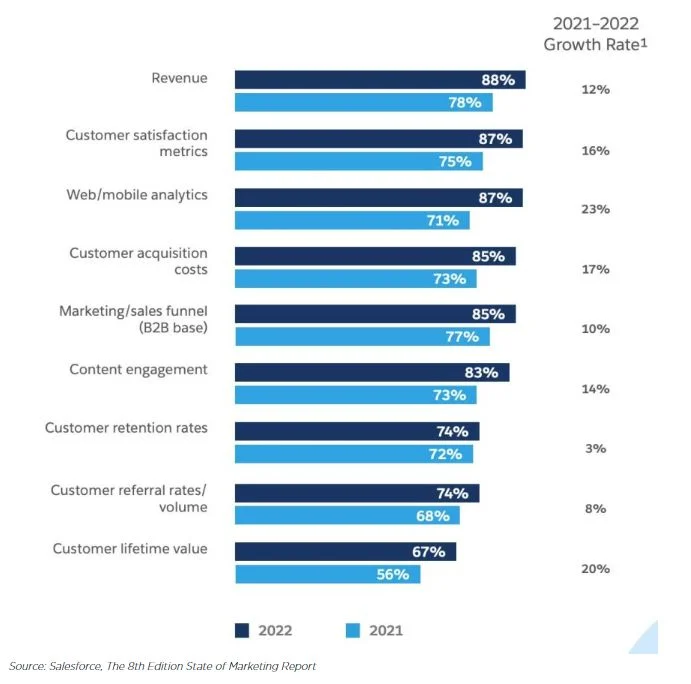
It’s true that some classic KPIs—like revenue and customer acquisition costs—have also seen impressive growth rates. However, there has also been a significant increase in KPIs like web/mobile analytics (23 percent growth rate), customer satisfaction metrics (16 percent growth rate), and customer lifetime value (20 percent growth rate).
These KPIs are less direct than revenue and customer acquisition costs, but they’re also crucial for telling a more nuanced story.
Fully understanding and leveraging these KPIs can help you make better marketing decisions, especially when you’re navigating this new territory of a cookieless marketing future.
Use Contextual-Based Advertising
Now that third-party cookies are out of the picture, you may be wondering: How can I know which ads to place where if I don’t have data about consumer behavior?
That’s where contextual advertising comes in. In context-based advertising, ads appear on web pages according to the website’s content. For example, a tech blog may display ads about computer accessories, while a vegan-living website may display ads about vegan food products.
Look at the New York Times Books section for another example.
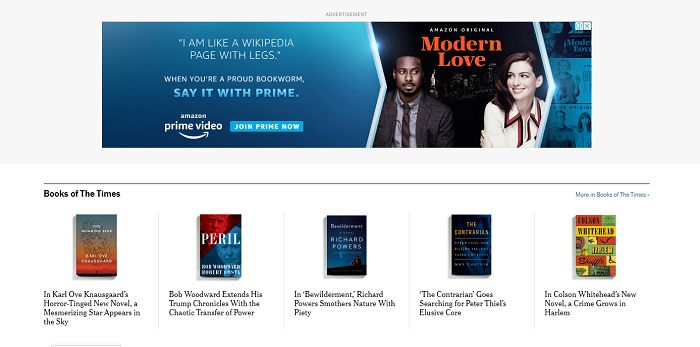
The Amazon Prime Video ad copy literally talks about being a “bookworm.” This is contextual advertising, as users who read the NYT Books section are obviously readers in some capacity.
One more: Look at The Wall Street Journal’s Life and Work section. It has a classic lifestyle content ad, considering users visiting this section have already shown an interest in lifestyle content.

Target Based on Location and Time
Say you want something more personal than contextual advertising. Then consider targeting users based on their current location and time of the day.
This can be as simple as “geotargeting,” where you change the ad copy to suit users from different regions. You see this in most search results.
For example, if you look up “coffee shops” from New York, you’ll see ads and search results for coffee shops in NY, even if the same brand has a franchise elsewhere.
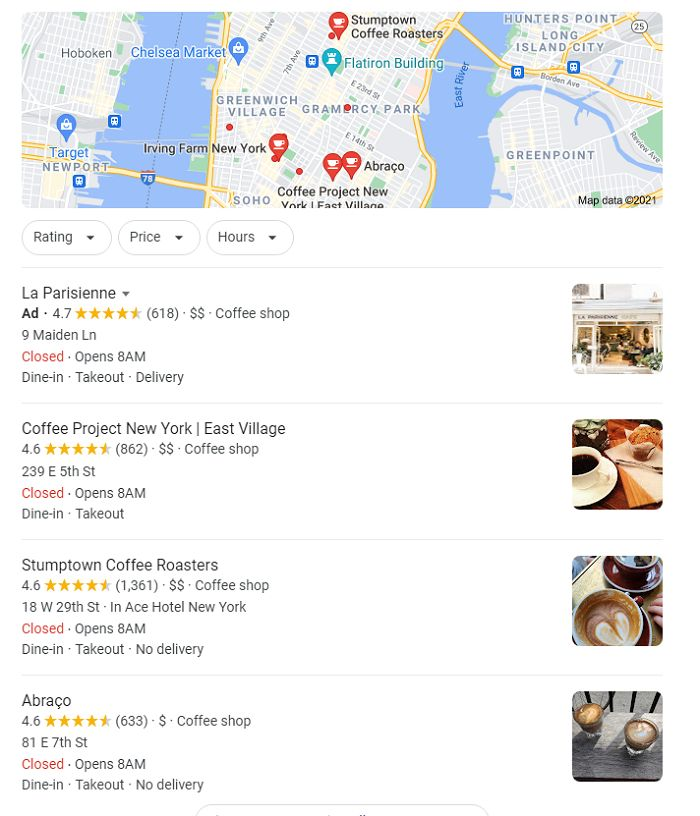
The most interesting part? It doesn’t even have to be a huge brand. As long as the business has a web presence and uses geotargeted ads, it will show up for location-based searches.
Time-based marketing is similar, with the only difference being you’re now using time data to personalize your copy. Imagine getting an email greeting you with a “good morning” when it’s actually morning in your region. Feels good, doesn’t it?
This approach can also be useful to determine when ads will appear for users.
Say you want to market coffee products. It’s better to show these ads in the morning when users consider buying coffee rather than at night when they are more likely to avoid it.
FAQs
Cookies are bits of data that contain identifiers for consumers (personal and usage information), so cookieless marketing relies less on them than other marketing approaches. This approach involves using first-party data and personalization to increase the effectiveness of ad campaigns.
Most marketing teams were used to using third-party cookies for launching marketing campaigns. Losing access to those would mean you have to rethink your strategy, find better ways to collect information (first-party data), and personalize ad campaigns without relying on cookies.
There are plenty of cookieless attribution techniques that you can use to track user behavior.
Perhaps the most innovative method is device fingerprinting. This method assigns unique user IDs to web visitors using a collection of data points (e.g., screen resolution, browser, preferred color scheme). Device tracking then tracks the user in the same way as they would if a site was using cookies, but without breaking privacy laws. Another method is API-based tracking, which utilizes advertising and marketing data from web servers or CRMs.
There are two things marketers should focus on when adapting to a cookieless landscape: first-party data and new cookieless attribution techniques (e.g., device fingerprinting, server-side tracking). First-party data enables marketers to own and use the data to its fullest extent. This is especially useful for remarketing campaigns. Cookieless attribution techniques are important, too, because they provide more generalized information that speaks to user behaviors and website performance. You can also use this data to target more generalized audiences within your marketing strategy.
Two of the greatest challenges of marketing without cookies are the inability to track users across devices effectively and the inability to attribute conversions to specific marketing campaigns accurately. The lack of granular data can make campaign optimizations difficult. However, you have an opportunity here to grow your first-party data, which can be a more effective marketing method. First-party data is more accurate than third-party data, and it’s also provided willingly by users who are presumably more likely to convert.
Conclusion
Marketing without cookies may seem daunting at first. However, it doesn’t have to be so hard.
Get things started by collecting first-party data and setting up cookieless attribution in GA4.
Using the strategies and tips outlined above, you can improve your ad campaigns without relying on third-party cookies to find marketing success.
The best part is that these methods give you more control and accuracy than cookie-based marketing, which has you sharing data with your competitors.

